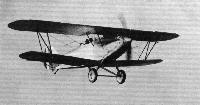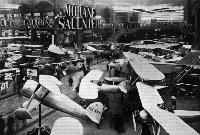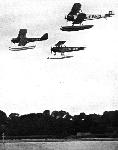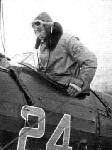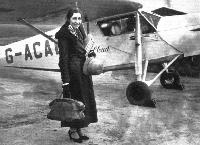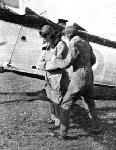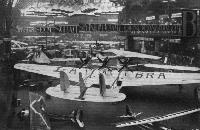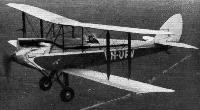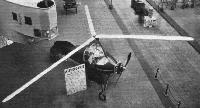Фотографии
-
THE HAWKER STAND: On the right the "Hart" ("Kestrel") of No. 57 Squadron, which has done 740 hours' flying. In the foreground the stainless steel fuselage for the "Osprey," which is one of the greatest attractions of the Show.
Самолёты на фотографии: Hawker Hart - Великобритания - 1928Hawker Osprey - Великобритания - 1930
-
THE HAWKER "HART": The machine to be exhibited in Paris is one which has been in service for a long period with an R.A.F. Squadron.
Самолёты на фотографии: Hawker Hart - Великобритания - 1928
-
THE BRISTOL "BULLDOG," 1933 MODEL: This is the aircraft which will be exhibited on the Bristol stand in Paris.
Самолёты на фотографии: Bristol Bulldog - Великобритания - 1927
-
THE 1933 "BULLDOG": Behind it on the Bristol stand is a skeleton wing in stainless steel.
Самолёты на фотографии: Bristol Bulldog - Великобритания - 1927
-
A NEW BOEING PURSUIT PLANE: Marking a radical departure in the construction of pursuit type aeroplanes, the Boeing Airplane Company of Seattle has built and delivered to the U.S. Army Air Corps three experimental low-wing, all-metal, "Wasp"-powered fighters, designated by the Army as Model XP 936.
Самолёты на фотографии: Boeing P-26 Peashooter - США - 1932
-
Armstrong-Whitworth (Type A.W.XVI)
Самолёты на фотографии: Armstrong Whitworth Scimitar / A.W.16 / A.W.35 - Великобритания - 1931
-
Регистрационный номер: G-ABXP LANDING EXTRAORDINARY: The latest type of experimental Autogiro has no fixed wing, no ailerons, and no elevator. Control is by tilting the rotor direct. The machine can be landed with its tail wheel touching first, the rest of the aircraft then sinking quite slowly to earth. When this picture was taken Mr. de la Cierva was landing the machine in this fashion.
Самолёты на фотографии: Cierva/Avro C.19 - Великобритания - 1929
-
FAIREY "FIREFLIES" IN BELGIUM: A line-up of the machines at Nivelles.
Самолёты на фотографии: Fairey Firefly - Великобритания - 1925
-
THE FAIREY MACHINES: In this view the wings of the "Fox" rather hide the "Firefly," but actually on the stand both machines are readily viewed, which, needless to say, means admired.
Самолёты на фотографии: Fairey Firefly - Великобритания - 1925Fairey Fox - Великобритания - 1925
-
Регистрационный номер: K1926 THE HAWKER "FURY": A single-seater interceptor fighter with Rolls-Royce Kestrel engine.
Самолёты на фотографии: Hawker Fury - Великобритания - 1931
-
Бельгийские R.31 уцелели после первых налетов Люфтваффе на их аэродромы, состоявшихся 10 мая 1940 года. Они совершили 41 разведывательный вылет для поддержки войск, последний вылет бельгийских ВВС в войне состоялся 27 мая.
A BELGIAN TWO-SEATER RECONNAISSANCE MONOPLANE: The Renard R.31 is fitted with a Rolls-Royce "Kestrel" engine and is credited with a speed of 335 km./h. (208 m.p.h.) at 13,000 ft.Самолёты на фотографии: Renard R.31 / R.32 - Бельгия - 1932
-
FAIREY "FOXES" IN BELGIUM Machines lined up at Evere.
Самолёты на фотографии: Fairey Fox - Великобритания - 1925
-
THE POTEZ 49: The lower wing is detachable, so that the machine can be turned into a monoplane.
Самолёты на фотографии: Potez Potez 37 / 39 / 49 - Франция - 1930
-
The "Gordon" as a Seaplane.
Самолёты на фотографии: Fairey Gordon / Seal - Великобритания - 1931
-
Регистрационный номер: G-ABCJ Saro "Cloud"
Самолёты на фотографии: Saunders-Roe Cloud / A.19 - Великобритания - 1930
-
THE C.A.M.S. (S.G.A.) 55 The hull is of all-metal construction, with Duralumin planking
Самолёты на фотографии: CAMS CAMS 55 - Франция - 1928
-
THE THIRTEENTH INTERNATIONAL AERO SHOW AT PARIS: In the foreground of this general view are the Morane-Saulnier machines. The large monoplane behind them is the Latecoere Lat. 290.
Самолёты на фотографии: Latecoere Late 290 - Франция - 1931Morane-Saulnier MS.225 - 227 / MS.275 - Франция - 1932
-
THE POTEZ 45: This is a "catapultable" flying boat for coastal patrol. Note the unusual placing of the engine.
Самолёты на фотографии: Potez Potez 45 / 452 - Франция - 1932
-
Регистрационный номер: G-ABIR, G-ABKB [2], G-EBKQ [2], HM504 WITH "BOOTS" ON: The A.S.T. seaplane fleet flying over our photographer at Hamble. Left to right, the " Avian," "Tutor," "504."
Самолёты на фотографии: Avro Avian / Type 594/616 - Великобритания - 1926Avro Avro 504N - Великобритания - 1920Avro Tutor/Sea Tutor/Prefect / Type 621/646/626 - Великобритания - 1929
-
THE AVRO 626: A training type used for flying training and military training (gunnery, bombing, photography, radio, etc.).
Самолёты на фотографии: Avro Tutor/Sea Tutor/Prefect / Type 621/646/626 - Великобритания - 1929
-
LORD LONDONDERRY: Secretary of State for Air arriving in an Avro "Trainer."
Самолёты на фотографии: Avro Tutor/Sea Tutor/Prefect / Type 621/646/626 - Великобритания - 1929
-
Регистрационный номер: K2496 Avro "Tutor"
Самолёты на фотографии: Avro Tutor/Sea Tutor/Prefect / Type 621/646/626 - Великобритания - 1929
-
THE PERCIVAL "GULL": A private owner's three-seater with Cirrus-Hermes IV engine.
Самолёты на фотографии: Percival Gull - Великобритания - 1932
-
Регистрационный номер: G-ACAB WELL EQUIPPED: Mrs. J. A. Mollison (Amy Johnson) ready to leave for the Cape.
Самолёты на фотографии: De Havilland Puss Moth / D.H.80 - Великобритания - 1929
-
ROUND THE WORLD IN A FLYING BOAT: Von Gronau and his crew in the Dornier Wal which has just completed a world flight.
Самолёты на фотографии: Dornier Do.J II / Do.15 Wal - Германия - 1931
-
THE A.N.F. MUREAUX 170 C.1: This is a single-seater fighter with "gull" shaped wings.
Самолёты на фотографии: ANF Mureaux Mureaux 170 - Франция - 1932
-
Blackburn "Iris V"
Самолёты на фотографии: Blackburn Iris / R.B.1 - Великобритания - 1926
-
A MILITARY REPRESENTATIVE AT HANWORTH: An Armstrong Whitworth "Atlas" Mark II (Panther engine). This machine has wings of CYH section, and seems to hang in the air remarkably well at low speed. Note the anti-drag engine cowling.
Самолёты на фотографии: Armstrong Whitworth Atlas / Ajax - Великобритания - 1925
-
ARRIVAL OF VICE CHANCELLOR: Rev. F. J. Lys, M.A., being assisted out of his machine by his pilot, Wing. Com. Park, and the A.O.C. in C.
Самолёты на фотографии: Armstrong Whitworth Atlas / Ajax - Великобритания - 1925
-
Регистрационный номер: G-ABKB [2] AT THE SLIPWAY: A.S.T. have their own slipway at Hamble so that getting their seaplanes afloat does not present much difficulty.
Самолёты на фотографии: Avro Avian / Type 594/616 - Великобритания - 1926
-
BLERIOT MACHINE: The 111 commercial machine with retractable undercarriage.
Самолёты на фотографии: Bleriot Bleriot-111 - Франция - 1929
-
SIR GEOFFREY SALMOND: Beside the Fairey III.F in which he flew from Northolt.
Самолёты на фотографии: Fairey Fairey IIIF - Великобритания - 1926
-
Регистрационный номер: F-ALME CONDUITE INTERIEURE: The Farman F.355 is a two-seater light plane with "Renault" engine.
Самолёты на фотографии: Farman F.230 / F.350 - Франция - 1930
-
GENERAL AIRCRAFT CO.'S ST4: A similar machine (two Pobjoy engines) will be exhibited at the Paris Aero Show.
Самолёты на фотографии: General Aircraft Monospar ST-4 - ST-12 - Великобритания - 1932
-
ANOTHER GREENLAND AIR SURVEY: One of the Danish Heinkel seaplanes.
Самолёты на фотографии: Heinkel HE.1 - HE.5, HE.8 - HE.9 - Германия - 1923
-
THE LATEST TREND: Mr. Lowe-Wylde - as usual pioneering - with his latest venture. He has, for experimental purposes only, added a motor-cycle engine to his B.A.C. VII two-seater and has already done a considerable amount of successful flying with this combination.
Самолёты на фотографии: Kronfeld Drone - Великобритания - 1932
-
LIORE & OLIVIER: The large Leo 30 four-engined bomber, the 4-wheeI undercarriage.
Самолёты на фотографии: Liore et Olivier LeO 300 - Франция - 1933
-
Регистрационный номер: I-ABRA FROM THE GALLERY: The Grand Palais as it appears when viewed from the Northern end. In the foreground the Italian stand.
Самолёты на фотографии: Savoia-Marchetti / SIAI S.66 - Италия - 1931
-
AT BELGRADE: Mr. Jojkitch; Mr. Ballardie; Mr. Mapplebeck; Capt. Markitchevitch, President of the Military Commission; Col. Strange, and three other members of the Commission. The party on the right includes, facing the camera, Lt. Col. Tomic, Commandant of the Belgrade Aerodrome, who is understood to be the senior pilot to have flown on active service in any Air Force in the world. (Balkan War, 1912, in a Bleriot.)
Самолёты на фотографии: Spartan Cruiser - Великобритания - 1932
-
Регистрационный номер: G-ABTY Spartan "Cruiser"
Самолёты на фотографии: Spartan Cruiser - Великобритания - 1932
-
Avro "Lynxes" of The University Air Squadron. The University Crest can be clearly seen.
Самолёты на фотографии: Avro Avro 504N - Великобритания - 1920
-
Регистрационный номер: G-EBKQ [2] FOR SEAMANSHIP: The good old Avro 504 is sufficiently difficult to handle on the water to teach pupils all there is to know about that side of the training; it is not used for flying training.
Самолёты на фотографии: Avro Avro 504N - Великобритания - 1920
-
Регистрационный номер: VH-UFV AROUND AUSTRALIA BY AIR: Mrs. H. B. Bonney, who flew round Australia last September, in flight over Essendon, Victoria.
Самолёты на фотографии: De Havilland Gipsy Moth / Moth X - Великобритания - 1928
-
The "MOTH" IN BRAZIL: Inspecting the "Moth" Training Squadron of 15 machines, of the Brazilian Navy, at the Ihla de Governador, in the Bay of Rio de Janeiro. In front, from left to right, are :- Admiral Bento Machado, Capt. Raul Bandeira, Admiral Protogenes Guimares (Minister of Marine), Capt. Adalberto Nunes (Commanding Naval Aviation), Capt. Netto dos Reis, Lt. Araujo (Chief Instructor).
Самолёты на фотографии: De Havilland Gipsy Moth / Moth X - Великобритания - 1928
-
A BRITISH SAILPLANE: The "Scud II" flying at the London Gliding Club's ground, Dunstable.
Самолёты на фотографии: Abbott-Baynes Scud - Великобритания - 1931
-
In the three-quarter front view the clean lines of the "Altis" are very clearly shown
Самолёты на фотографии: Vine Altis - ЮАР - 1932
-
ON SAILPLANE PRINCIPLES: An interesting little single-seater which has been built in the Transvaal, S.A. With the A.B.C. "Scorpion" it cruises at 60 m.p.h. comfortably, and has a landing speed of about 30 m.p.h.
Самолёты на фотографии: Vine Altis - ЮАР - 1932
-
This three-quarter rear view of the "Altis" brings out the wisdom of the adage that "when an aircraft looks right, it generally is right." The tail units in particular appear very sensibly planned.
Самолёты на фотографии: Vine Altis - ЮАР - 1932
-
The peculiarly "birdlike" form of the fuselage is brought out.
Самолёты на фотографии: Vine Altis - ЮАР - 1932
-
The "Altis" is shown in flight
Самолёты на фотографии: Vine Altis - ЮАР - 1932
-
The method of obtaining the flexible trailing edge. The top and bottom rib caps are both free to slide.
Самолёты на фотографии: Vine Altis - ЮАР - 1932
-
The drawing shows the method of bracing the single wing spar. The tube at the end carries the rotating tip.
Самолёты на фотографии: Vine Altis - ЮАР - 1932
-
Altis
Самолёты на фотографии: Vine Altis - ЮАР - 1932
-
BLERIOT MACHINE: The 290 amphibian flying boat
Самолёты на фотографии: Bleriot Bleriot-290 - Франция - 1931
-
HETEROGENEITY: The machine in the foreground of this general view is the Caudron P.V.200.
Самолёты на фотографии: Caudron PV.200 - Франция - 1932
-
LIORE & OLIVIER: The C.L.10 Autogiro.
Самолёты на фотографии: Liore et Olivier CL.10 - Франция - 1932
-
A LeO AUTOGIRO: An artist's impression of the little side-by-side two-seater which is now being built under licence in France by the Liore & Olivier firm. The machine, which is fitted with a Pobjoy engine, will be exhibited at the forthcoming Paris Aero Show.
Самолёты на фотографии: Liore et Olivier CL.10 - Франция - 1932
-
TAILLESS: The Nieuport-Delage 941 light plane has a 3-wheel undercarriage, the single front wheel being steerable.
Самолёты на фотографии: Nieuport-Delage Ni-D-940 - Франция - 1932
-
AIR-COOLED PASSENGERS: The Nieuport-Delage 590 "Colonial" monoplane has an open "balcony" which gives the machine gunners a free field and at the same time protects them from the slipstream.
Самолёты на фотографии: Nieuport-Delage Ni-D-590 - Франция - 1932
Статьи
- Flight

